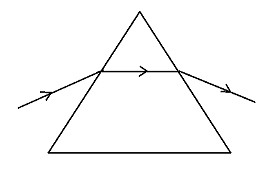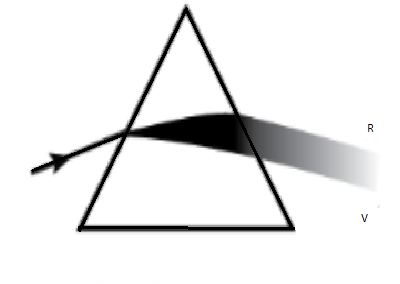
Which of the following figures is correct when a monochromatic light passes through a prism?
A)

B)

C)

D) None of the above
Answer
143.1k+ views
Hint: Monochromatic light is a single colored light which is electromagnetic radiation derived from electromagnetic radiation from the atoms. Such lights have only one color and single wavelength. When white light passes through a prism it splits into its component colors. Monochromatic light has no such components.
Complete step by step solution:
Monochromatic lights are obtained when photons emission takes place. During this process the electromagnetic radiation leads to the production of monochromatic light. It is not made up of any components of visible light. When a monochromatic light is directed to pass through a substance or material, it induces transitions which are characteristic to the chemical properties of the constituent elements of such material.
When white light is made to pass through a prism it splits into its component colors. Since there are seven different colors of which visible light is made up of. Hence they split based on their wavelength. Similar thing happens when a monochromatic beam of light is made to pass through a prism. The monochromatic light will have some wavelength. The light will have some angle of deviation when it emerges out from the prism. Just like any single visible ray of light. The angle of deviation will depend on the wavelength of light.
From the above discussion, it is clear that monochromatic light when passed through prism will have some angle of deviation but it won’t split into any component of light. Also the light won't travel in a straight line when it emerges out of the prism.
Hence Option A is the correct option.
Note: It should be noted that monochromatic is single colored light ray.
Monochromatic light is one of the light as observed in the spectrum of visible light. As the spectrum of white light has some angle of deviation when it passes through prism, hence monochromatic light will also have some angle of deviation.
Complete step by step solution:
Monochromatic lights are obtained when photons emission takes place. During this process the electromagnetic radiation leads to the production of monochromatic light. It is not made up of any components of visible light. When a monochromatic light is directed to pass through a substance or material, it induces transitions which are characteristic to the chemical properties of the constituent elements of such material.
When white light is made to pass through a prism it splits into its component colors. Since there are seven different colors of which visible light is made up of. Hence they split based on their wavelength. Similar thing happens when a monochromatic beam of light is made to pass through a prism. The monochromatic light will have some wavelength. The light will have some angle of deviation when it emerges out from the prism. Just like any single visible ray of light. The angle of deviation will depend on the wavelength of light.
From the above discussion, it is clear that monochromatic light when passed through prism will have some angle of deviation but it won’t split into any component of light. Also the light won't travel in a straight line when it emerges out of the prism.
Hence Option A is the correct option.
Note: It should be noted that monochromatic is single colored light ray.
Monochromatic light is one of the light as observed in the spectrum of visible light. As the spectrum of white light has some angle of deviation when it passes through prism, hence monochromatic light will also have some angle of deviation.
Recently Updated Pages
How to find Oxidation Number - Important Concepts for JEE

How Electromagnetic Waves are Formed - Important Concepts for JEE

Electrical Resistance - Important Concepts and Tips for JEE

Average Atomic Mass - Important Concepts and Tips for JEE

Chemical Equation - Important Concepts and Tips for JEE

Concept of CP and CV of Gas - Important Concepts and Tips for JEE

Trending doubts
JEE Main 2025 Session 2: Application Form (Out), Exam Dates (Released), Eligibility, & More

JEE Main Exam Marking Scheme: Detailed Breakdown of Marks and Negative Marking

JEE Main 2025: Derivation of Equation of Trajectory in Physics

Electric Field Due to Uniformly Charged Ring for JEE Main 2025 - Formula and Derivation

Electric field due to uniformly charged sphere class 12 physics JEE_Main

Degree of Dissociation and Its Formula With Solved Example for JEE

Other Pages
JEE Advanced Marks vs Ranks 2025: Understanding Category-wise Qualifying Marks and Previous Year Cut-offs

JEE Advanced 2025: Dates, Registration, Syllabus, Eligibility Criteria and More

JEE Advanced Weightage 2025 Chapter-Wise for Physics, Maths and Chemistry

Physics Average Value and RMS Value JEE Main 2025

Dual Nature of Radiation and Matter Class 12 Notes: CBSE Physics Chapter 11

Formula for number of images formed by two plane mirrors class 12 physics JEE_Main




